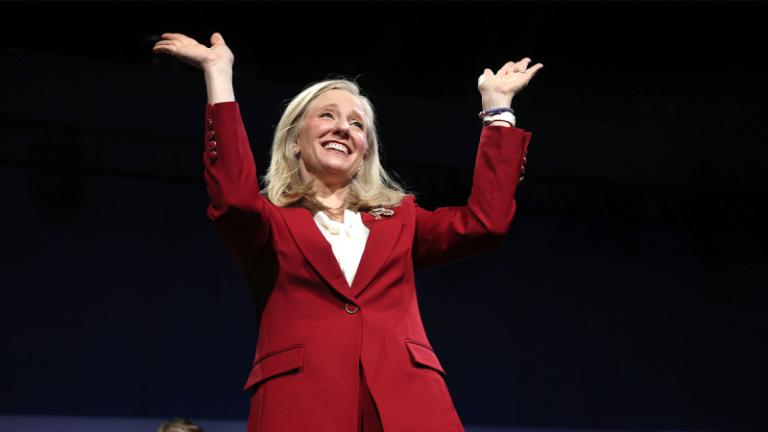One year ago, Donald Trump won a transformative election victory, sweeping all seven swing states, the popular vote, and moving all fifty states redder than they were in 2020.
How did he do it?
By motivating men, young men in particular, and sports fans who were fed up with the insanity of men winning women’s sports championships. I wrote about the victory in my new book, ‘Balls,’ which was released on Tuesday.
The book addresses the landslide Trump victory, but it also asks an important question when looking forward prospectively: Now that Trump, unfortunately, isn’t able to run for reelection, how do Republicans ensure that the Trump MAGA coalition extends, and even grows, beyond his own presidency?
In 2024, the two most conservative voting groups in America were male senior citizens and young men under the age of thirty.
This has never happened before in any of our lives.
It was a cultural transformation overnight.
Trump also won record support among White, Black, Asian and Hispanic men as well, but that same momentum didn’t extend to 2025. Indeed, Tuesday’s voting results paint an ominous picture of what 2026 and 2028 could look like if young men aren’t motivated to show up and vote like they did in 2024.
Consider the numbers: in 2024, Trump received 1.968 million votes in New Jersey and 2.075 million votes in Virginia. While he lost both states by narrow margins to Kamala Harris — by roughly 5% — he received more votes than the Virginia Democrat candidate for governor, Abigail Spanberger — who won Virginia with 1.961 million votes — and the New Jersey Democrat candidate for governor, Mikie Sherrill — who won New Jersey with 1.792 million votes.
So how did both Democratic gubernatorial candidates win election comfortably despite receiving fewer votes than Trump did in their states a year ago? Yes, partly because it was an off-year cycle and overall turnout trended down, but they won comfortably because roughly 600,000 Trump voters didn’t show up to vote in 2025 who did show up to vote in 2024.
Who are these voters?
Young men, sports fans, blue collar workers, the Trump MAGA base that will come out to support Trump when he’s on the ballot, but won’t show up when he’s not on the ballot.
So will these voters return in 2026 and in 2028 when Trump isn’t on the ballot? That depends on how well future Republican candidates speak to these voters. Some of y’all will think I’m crazy for telling you this, but as soon as the 2026 mid-term elections are over, expect a pivot so rapid it will make your head spin — Democrats in 2027 will all argue that Trump’s unique political gifts end with him, that MAGA is over without Trump as its leader. Yep, from ‘He’s Hitler!’ to ‘He’s the most talented Republican president in any of our lifetimes,’ almost overnight.
I’m telling you, it’s coming.
Because Democrats are going to bank on Trump as a political unicorn, a candidate so talented that only he could power a coalition as substantial as he won in 2024.
So what do Republicans need to do to extend and even grow Trump’s appeal with young men? I think it’s a combination of three things, wed the policy and the personal together, as Trump has been uniquely talented at doing.
1. On the policy front, the 2024 election was about the economy, the border, and crime
It was as easy as EBC.
Trump won the arguments on all three of these fronts. So far, Trump 2.0 has ended the border as an issue by ending illegal immigration and driven crime down to record lows in many states and cities. His challenge on the economy is that Biden was so bad, it’s taking time to clean up his mess. With record high stock prices and record low gas prices, Trump is delivering for all of us with stock market assets and all of us who have to fill up our tanks.
But there’s a lingering anger over how much goods cost. Even I feel it each time I buy a Chick-fil-A meal for my family and it costs over $50. For fast food, really!
Prices went up so fast under President Joe Biden that the sticker shock is still real even in 2025. Trump has stopped the rapid price increases and, in the case of some purchases like gas, has actually brought them back lower than they were during Biden, but that bitter aftertaste of inflation takes time to wear off.
So far it hasn’t.
2. Focus on men in women’s sports
Is it the most important issue in the country?
No.
But it crystallizes the absurdity of Democrat policies for young men and sports fans, who provided the fuel to Trump’s record win in 2024.
If you believe a man should be able to win a women’s sports championship, how can I trust your opinion on anything? As I wrote in ‘Balls,’ this issue, combined with EBC, won Trump the election in 2024.
I think that will still be the message in 2026, too, because, amazingly, Democrats have doubled and tripled down on defending men in women’s sports all over the country.
This issue isn’t going away.
3. HAVE FUN and BE ENTERTAINING.
My two favorite moments of the 2024 campaign were when Trump dressed up as a McDonald’s employee and as a garbage man and rode around in a garbage truck.
Was it absurd and ridiculous?
Of course.
But the number one gift Trump has that he receives zero credit for is this: HE’S FUNNY!
Yes, politics are serious. But they should also be fun. Trump is a happy warrior and happy warriors win.
The two most successful Republican presidents of my life were Ronald Reagan and Donald Trump. Both were, in many respects, professional entertainers. They knew how to cut through the noise and were authentic in the way they did so.
Trump isn’t perfect, none of us are, but he’s the most comfortable president in his own skin that any of us have ever seen and he has tremendous political instincts.
You can spend a hundred million on an ad campaign and not get the free media attention that Trump did, scooping out fries and talking with voters at the drive-thru in Pennsylvania. That style of politicking is unbeatable. Heck, I would argue the best version of Trump is the one you get in fast food restaurants. He genuinely loves getting out and interacting with people. That’s a skill that can’t be taught, but it can be emulated.
We used to ask the question, which candidate would you rather have a beer with? While Trump doesn’t drink — as he’s jokingly said, can you imagine what he’d say if he drank? — he’s authentic and real. As artificial intelligence takes over much of the country, I believe authenticity will become the most important political key to the realm.
Young people in particular, who are steeped in social media artificiality fed to them constantly on their phones, have an innate sense of when they’re being poll-tested and marketed to, they sniff it out better than older voters.
If you want them to show up and support you, you have to win their trust.
Which is why I truly believe the election was over when it came to male voters when Trump was shot in Butler, Pennsylvania.
In that moment, having escaped death by half an inch, Trump, whose critics had labeled him a phony, rose up and screamed, ‘Fight, fight, fight!’ three times. At that instant, the election was over for male voters.
It was the bravest presidential moment of my life.
But it was also one of the most authentic.
In times of great peril, your own personal character is revealed. In those perilous milliseconds, Trump became a legend and won the election.
He proved once and for all he had ‘Balls.’
And so far no Democrat has proven that they do.
So long as that remains the case, Republicans aren’t going to lose men.
Which is why the best example of an oxymoron in America today isn’t ‘jumbo shrimp,’ it’s ‘masculine Democrat.’
Because after all, there are certainly big shrimp, but there are still no masculine democrats.
Clay Travis is the author of the new book, ‘Balls: How Trump, Young Men and Sports Fans Saved America.’ Buy it here.
This post appeared first on FOX NEWS










